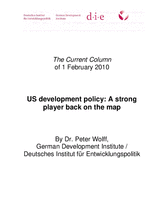US development policy: a strong player back on the map
Wolff, PeterThe Current Column (2010)
Bonn: German Development Institute / Deutsches Institut für Entwicklungspolitik (DIE) (The current column of 1 February 2010)
Bonn, 1 February 2010. Under the Bush administration development policy was not an especially important issue – although the US development budget did increase in the period, and not only on account of Afghanistan and Iraq. Aid for Africa also rose appreciably, not least with a view to counteracting public perceptions of the US as the world’s dominant military power. The PEPFAR AIDS-relief initiative and the Millennium Challenge Account were development initiatives advanced by US development policy in this period - each with a decidedly national accent and neither coordinated in any particular way with other donors. In this period USAID had largely vanished from the map.
A programmatic address that Secretary of State Hillary Clinton held on January 6 at the Washington Center for Global Development has signalled the change of course envisioned by the Obama administration. But those who were convinced that the new administration was about to set new multilateral accents are now forced to face more sobering realities. Indeed, “…American know-how, American dollars, American values…” (Clinton) figure prominently among the new administration’s concerns, and the Secretary of State left no doubt that the only possible way to induce Congress to appropriate the necessary funds was to subscribe publicly to this chiefly bilateral approach. The US taxpayer is not to be won over with appropriations for multilateral organisations or actions coordinated together with the donor community.
Clinton has stressed unmistakably the US’s national interest in sustainable global development, pointing to the political-strategic role played by development policy: The main concern is not (only) humanitarian engagement but efforts to secure political and economic stability and to solve global problems, and in making this point, Clinton is putting development policy on an equal footing with foreign and security policy (Diplomacy-Defense-Development), subscribing to what she calls “the whole of government approach,” with development policy the task not of one government agency but of the whole of government. We shall see how this principle is implemented, say, in connection with reconstruction efforts in Haiti.
USAID is set to become, again, one of the world’s leading development agencies and to work closely together with the agencies responsible for diplomacy and defence. There are plans to boost the capabilities of US foreign policy to project influence abroad in order to push through development programmes against resistance in partner countries. Development policy’s efforts to promote democracy and good governance are to serve US foreign policy in reaching its goals. Military and development aid are already working closely together in a number of fragile states. The fact that the US is pursuing an “integrated” foreign-policy course of this kind is certainly nothing new. But one thing that is new is that the role played by development policy is being upgraded, with far more emphasis placed on the development-security nexus.
The “whole of government approach” also includes coordination of the international efforts of US government agencies (e.g. environment, agriculture, health). The State Department and USAID have been assigned the task of leading, coordinating, and supporting international cooperation in all fields, and the two agencies’ staffing levels are being increased accordingly. What this means in effect is that there is every reason to expect the US to launch large-scale initiatives in the fields of food security, health, and democracy promotion. It will then be more the other donors than the US that will need to deal with the issue of inter-donor coordination and division of labour. The new administration is virtually certain to set priorities concerning the introduction of new technologies (green revolution, mobile banking), and Clinton leaves no doubt that these technologies, including those for use in the environmental sector, will for the most part be US technologies, because otherwise there would be no mobilising support in Congress to secure the appropriations needed for the new strategy. To this end, Congress and the US taxpayer are to be told a “better story” on the global role of US development policy.
There is some doubt as to whether the funds the US has announced for climate policy in developing countries – that is, the US share of the US$ 100 billion discussed in Copenhagen – will be made available in addition to the funds earmarked for development aid. There is some reason to believe that the funds made available e.g. for rural development and food security will be justified in terms of both development and climate policy. That is, the US would then no longer distinguish clearly between funding provided for climate and development – whether the developing countries like it or not.
The Washington development establishment has received Clinton’s keynote address with marked enthusiasm. But now it will not be Congress but the administration that needs to prove it is capable of effectively implementing the concept it has advanced – including e.g. a new, enhanced role for USAID. After all, the Obama administration took one whole year even to develop the concept. In his recent State of the Union address, Obama declared job creation in the US to be his paramount political priority. In view of the difficult budget situation in the US, it is more than unlikely that that more funds will be appropriated for development policy. This fact itself may, possibly, impel the US to step back and take a hard look at the option of strengthening multilateral institutions and working for a more clearly defined division of labour with other donor countries.
